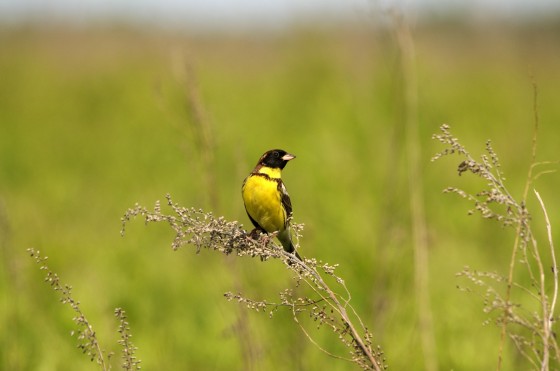
Global collapse in huge songbird population
With its canary-yellow colouring, the yellow-breasted bunting – about the size of a sparrow – is one of the more striking species of songbirds. Until a few years ago it was one of the commonest birds found in northern Europe and Asia. Since then, however, ornithologists have recorded sharp declines in many regions. In the last 18 months the yellow-breasted bunting has been included in the international Red List of endangered species as being "critically endangered". Just how dramatic the decline is, is now shown in its entirety for the first time in a comprehensive new study carried out by scientists from Germany, England, Russia, Finland and Japan. The researchers document the global collapse in the bird’s population. They see the main cause in the extremely widespread poaching of the birds in China.

The yellow-breasted bunting’s breeding grounds cover almost 16 million square kilometres, from Finland in the west to the Russian Pacific coast and Japan in the east. The birds fly over China to south-east Asia, where they overwinter. In the 1980s ornithologists still estimated the global population at hundreds of millions. Between 1980 and 2013, however, the population decreased by around 90 percent, as the new study shows. Its distribution range in the west has shrunk by around 5000 kilometres – in the European part of Russia, the yellow-breasted bunting has practically become extinct. "Such a rapid and steep decline in a species which is spread over such an enormous area is very rare," says Dr. Johannes Kamp, the lead author of the study and a landscape ecologist at Münster University. The scientists compare this collapse with the extermination of the passenger pigeon in North America in the 19th century. At that time billions of these pigeons fell victim to rampant hunting on the part of humans – until the species was extinct.

"Our study is just scratching at the surface of a problem that is set to become an even greater issue – and other songbirds are affected too," says Johannes Kamp. Although the hunting of protected songbirds has been illegal in China since 1997, he says, increasing numbers of the birds are being caught on their migratory routes because the animals are seen as a culinary delicacy, and demand for them is increasing with growing affluence in the country. "Although the Chinese Government is trying to curb the poaching and illegal sale of the yellow-breasted bunting, it is very easy to buy the birds on the black market there," says Japanese ornithologist Simba Chan, the co-author of the study and representative of the Asian section of "BirdLife International", an umbrella organisation for conservation. In one single concerted action in November 2011, Chinese law-enforcement officers confiscated two million captured songbirds in two cities in Anhui Province in south-western China. Included among these birds were 20,000 yellow-breasted buntings. Although there are no official figures, scientists believe – basing their view on population modelling – that it is realistic to assume that several million yellow-breasted buntings are trapped every year in South-East Asia.
Long-term monitoring in Finland and Russia
"Although we cannot rule out other factors influencing the dramatic decline in the yellow-breasted bunting population, over and above poaching," Johannes Kamp concedes, "a loss of habitat alone cannot explain the scale." There are also indications, he says, that for example diseases or pesticides may play a role. For their investigations, the scientists had recourse to other data, including data obtained from the long-term monitoring of various breeding grounds in Finland and Russia, in particular in Siberia. They carried out computer simulations of the development of the bird population and found a connection to the bird trapping known from China.
Parallels to poaching in the Mediterranean
"The extremely widespread poaching of birds on their migratory route through Egypt is a big danger for our native birds – this is well documented," as Johannes Kemp points out. "However, we know much less about the Asian problem – although the dimensions are similar to those in the Mediterranean, if not even more dramatic," As Simba Chan adds: "We need more good, systematic studies on the populations of migratory birds in Asia. With international support we might succeed in reversing the declining trend in the population of the yellow-breasted bunting and of many other species of birds."
Original publication:
Kamp J. et al. (2015): Global population collapse in a superabundant migratory bird and illegal trapping in China. Conservation Biology online first, DOI: 10.1111/cobi.12537
